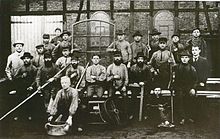Sophienhammer
The Sophienhammer is a technical cultural monument in the Arnsberg district of Müschede and today part of Julius Cronenberg oH
history
The Sophienhammer is one of the oldest industrial plants in the Röhrtal . The Iserlohn entrepreneur Hermann Dietrich Piepenstock had it built in 1835. He named the business after his wife Sophie. Until 1860, the company, which was temporarily owned by an entrepreneur from Hohenlimburg , produced blanks for sheet metal rolling mills with a charcoal fresh fire, especially for the nearby Hüsten trade union .
In 1870 the business was transferred to Carl-Julius Cronenberg, who came from a family of hammer mill owners from the area around Gevelsberg . The Cronenberg company was founded in Gevelsberg in 1711 as a horizontal bar and scythe hammer and moved to Körbecke in 1855 . Carl-Julius Cronenberg then moved the company headquarters to Müschede in the purchased Sophienhammer.
Carl-Julius Cronenberg switched production in Müschede to the industrial forging of scythes . For this purpose, the previous company buildings had to be demolished and completely rebuilt. The main energy was provided by water power from a hammer pit, which was derived from the pipe. In 1878 two more water wheels were installed. This enabled further forging hammers to be operated. The company was expanded in 1886 to include an iron foundry and a machine shop.
While only 100 scythes were produced in 1870, there were 1,000 in 1900. The distribution was carried out by Sauerland traveling traders . The Müscheder station on the Neheim-Hüsten – Sundern railway line was named Sophienhammer bei Müschede in 1900 . In 1902 Carl-Julius Cronenberg converted the company into a general partnership.
A technical modernization took place in 1922/23 when the old water wheels were replaced by a turbine system.
The Cronenbergs succeeded in increasing their market share in the scythe business by taking over previously competing companies. The companies F. Athmer from Schwagsdorf (1905), Andreas Schilli from Oberursel (1939), Franz Sonnleithner from Laussa (1961), HC Leymann from Sulingen (1964) and Kuhlmann & Sons as well as the Ennepetaler Sensenwerke (both 1992) were taken over. During this time, the company developed into the most important scythe manufacturer in Germany.
During the First World War, the company produced ammunition from December 1914. From 1918 on, additional electricity had to be drawn for energy supply. In 1944, 13 of the company's 49 workers were prisoners of war. When US troops occupied the village without a fight on April 13, 1945, their headquarters were set up in Sophienhammer. From the end of the war to December 1946, operations were idle.
When Dieter-Julius and Wilhelm Cronenberg joined the company in the late 1950s / early 1960s, the product range was expanded. Today this includes automatic door seals, flagpoles and barriers. Scythe production continues today, albeit on a much smaller scale.
Today Carl-Julius and Wilm-Hendric Cronenberg work in the company as the tenth generation of the Cronenberg family.
Buildings
The current factory was built in several construction phases since the middle of the 19th century. The historical core of today's factory was placed under monument protection due to its technical and economic historical importance, as large parts of the old facilities have been preserved to the present day. This includes the turbine house from the 1920s. The turbine was built by Voith in 1921 and the three-phase generator was supplied by Bergmann in Berlin . The electrical equipment and switchboard have also been preserved. The displays and controls are mounted on a marble board. The listed buildings also include an office and residential building with Art Nouveau elements . A building used as a warehouse and a workshop dates from 1878. In addition, there are elaborate hydraulic structures such as the Hammerteich, Hammergraben, ponds and dams.
The working group for village development and home development in Müschede looks after a small scythe museum.
literature
- Jürgen Schulte-Hobein: 140 years at the Sophienhammer. Sauerland 2011/3: 136-140
- Uwe Haltaufderheide: The architectural monuments of the city of Arnsberg. Collection period 1980–1990. City of Arnsberg, Arnsberg 1990, ISBN 3-928394-01-0 , pp. 219-221.
- Michael Senger: The Cronenbergs. From the scythe forging in the Sauerland region of the Mark and Electorate of Cologne. In: Michael Senger (Red.): Kiepe, plow and vice. Economic life in the Sauerland (= publications of the slate mining museum on regional history 19). Westphalian Slate Mining and Local History Museum, Schmallenberg-Holthausen 1999, ISBN 3-930264-24-2 , pp. 301-304.
- 300 years of Cronenberg. The history book of a family business. Julius Cronenberg oH, Arnsberg 2011, online (PDF; 10 MB) .
Web links
Coordinates: 51 ° 24 '17.4 " N , 7 ° 59' 34.5" E
